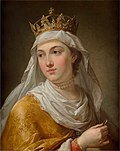This article has multiple issues. Please help improve it or discuss these issues on the talk page . (Learn how and when to remove these messages)
|
This is a list of princes of Galicia (Halych or Halychyna) and its sister principality Volhynia (Volyn' or Volodymyr; Latin: Lodomeria). They were basically separate principalities (rulers being closely related), until Roman Mstislavich "the Great" united Halych and Volhynia in 1199. [1] He was a prince ( knyaz ) of Volhynia who conquered also Halych, but immediately gave it to his son.[ which? ]
Contents
- Volhynia
- Princes of independent Volhynia
- Volhynia in the Kingdom of Halych-Volhynia
- Halych
- Princes of independent Halych
- Halych in the Kingdom of Halych–Volhynia
- Halychyna and Volynia (Halych–Volhynia)
- Romanovichi
- Piast Dynasty
- House of Anjou
- See also
- References
- Bibliography
- External links
They continued usually as separate states, but within the same dynasty and under vassalage to the knyaz of Halych until Lev,[ which? ] who annexed[ when? ] Volhynia to the principality. The royal crown lapsed and rulers were known as princes and/or dukes after the death of Andriy Yuriyovych (1323).










